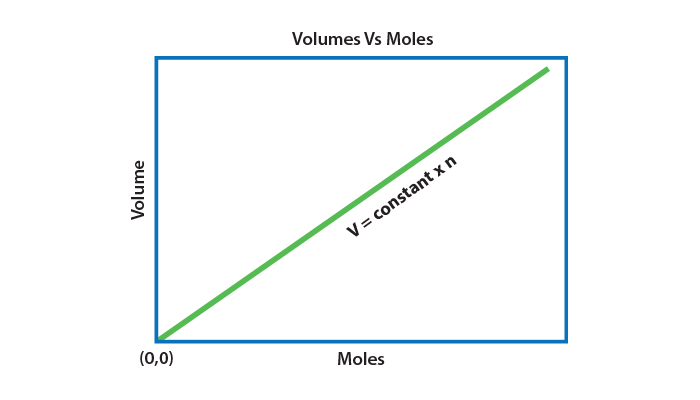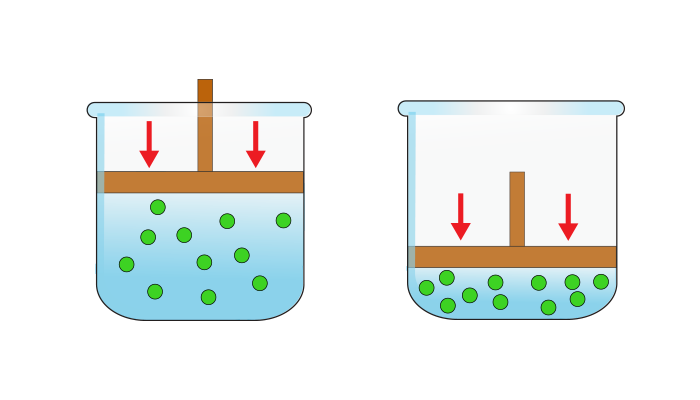
Avogadro's Law
Nov 02, 2022, 16:45 IST
Avogadro's Law, also known as Avogadro's Principle or Avogadro's Hypothesis , is a gas law that states that the total number of molecules/atoms of a gas (i.e., the amount of a gaseous substance) is also directly proportional to the volume of a gas occupies at a constant temperature and pressure.
Avogadro's Law is closely related to the ideal gas equation because it relates temperature, pressure, volume, and amount of substance for a given gas. Avogadro's Law is named after the Italian scientist "Amedeo Carlo Avogadro", who proposed that two ideal gases occupy the same volume at a given (constant) pressure and temperature must contain the same number of molecules.
| Table of Content |
Formula and Graphical Representation
At the constant temperature and pressure, Avogadro’s law can be expressed via the following formula:
V ∝ n
V/n = k
Where V = Volume of the gas
n = The amount of gaseous substance (often expressed in moles)
k = Constant
When the amount of the gaseous substance is increased, then the increase in the volume occupied by a gas can be determined with the help of the given formula-
V 1 / n 1 = V 2 / n 2 = k , (as per Avogadro’s law).
The graphical representation of the Avogadro’s law (with the amount of substance on the X-axis and the volume on the Y-axis) is mentioned below:

Here, the straight line (that indicates the two quantities are directly proportional) passes through the origin, implying that zero moles of gas will occupy zero volume.
Derivation
Avogadro’s law can be derived from an ideal gas equation, which can be expressed as-
PV = nRT
Where,
P = Pressure exerted by a gas on the walls of its own container
V = Volume occupied by the gas
n = Amount of gaseous substance (number of moles of gas)
R = Universal gas constant
T = Absolute temperature of the gas
Rearranging the ideal gas equation, the following equation can be written as:
V/n = (RT)/P
Here, (RT)/P = constant (since the pressure and temperature are kept constant and the quotient/product of two or more constants is always a constant). Therefore
V/n = k
Thus, the proportionality between the volume occupied by the gas and the number of the gaseous molecules is verified.
Molar Volume of a Gas
According to Avogadro’s law, the volume and amount of gaseous substance are constant (at constant temperature and pressure). The value of the constant (k) can be calculated with the following equation-
k = (RT) / P
Under the normal conditions for the temperature and pressure, the value of T equals to 273.15 Kelvin, and the value of P equals to 101.325 kilo Pascals. So, the volume occupied by one mole of a gas at STP is:
Volume occupied by 1 mole of a gas = (8.314 J.mol -1 .K -1 ) x (273.15 K) / (101.325 kPa) = 22.4 litres
Thus, one mole of any gaseous substance occupies 22.4 litres of the volume at STP.
Examples of Avogadros Law
The process of respiration is a perfect example of Avogadro's Law. When a person inhales, an increase in the molar amount of air in the lungs is accompanied by an increase in lung volume (lung expansion). A figure detailing the change in volume caused by an increase in the number of gas molecules is shown below.

Another common example of Avogadro's Law is the deflation of car tires. When the air trapped inside the tyre escapes, the number of moles of air present in the tyre is reduced. This reduces the volume occupied by the gas, causing the tire to lose its shape and deflate.
Limitations of Avogadro’s Law
- Although Avogadro's law is perfectly applicable to ideal gases, it provides only approximate relationships at best. Furthermore, the deviation of real gases from ideal behavior increases at high pressure and low temperatures.
- It is important to understand that gases with molecules composed of relatively low molecular weights (such as hydrogen and helium) obey the Avogadro's law to a greater extent than heavier molecules.
Solved Examples
Q1. 1 mole of a helium gas fills up empty balloon to the volume of the 1.6 litres. What would be the vol. of the balloon if an additional 2.4 moles of a helium gas is added? (Assume that the pressure and temperature are kept constant)
Ans. Given,
Initial amount of a helium (n 1 ) = 1 mol
Initial volume of the balloon (V 1 ) = 1.6 L
Final amount of helium (n 2 ) = 1 mol + 2.4 mol = 3.4 mol
Now, V 1 / n 1 = V 2 / n 2
So, the final volume of the balloon (V2) = (V 1 .n 2 ) / n 1 = (1.6L x 3.4mol) / 1mol = 5.44 L
The balloon would occupy a volume of 5.44 litres when it contains 3.4 moles of helium gas.
Q2. A tyre containing 20 moles of a air and occupying the volume of 60L loses half of its volume due to the puncture. Considering that the temperature and the pressure remain constant, what will be the amount of a air in the deflated tyre?
Ans. Given,
Initial amount of air (n 1 ) = 20 mol
Initial volume of the tyre (V 1 ) = 60 L
Final volume of the tyre (V 2 ) = 30 L
As per the Avogadro’s law, the final amount of a air in the tyre (n 2 ) = (V 2 .n 1 ) / V 1 = 10 moles.
The deflated tyre would contain 10 moles of air.
Frequently Asked Questions (FAQs)
Q1. Is Avogadro's law applicable for gases?
Ans. It is the gas pressure that determines its volume. That is why all gases have the same volume at the same pressure. Hence, Avogadro's Law is only applicable to gases.
Q2. What does Avogadro's law allow us to do?
Ans. Calculations for the relationships between the volume and the no. of moles of a gas can be calculated using Avogadro's Law.
Q3. What variables change in Avogadro's law?
Ans. The volume (V) of the ideal gas varies directly with the no. of the moles of a gas(n) when the temperature and the pressure(P) remain constant.
Q4. Is Avogadro's law inverse or direct?
Ans. According to the Avogadro's Law, at a constant pressure and temperature, the volume of the gas is always directly proportional to the number of moles for a confined gas.
Q5. Do all gases occupy the same volume?
Ans. As all gases which are behaving ideally have the equal number of density and they will all have the same molar volume. At STP this will be 22.4 L. This is useful if you want to envision the distance between molecules in different samples.









